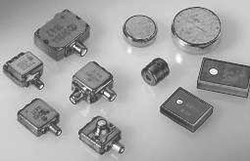Balanced Armature Transducer
Applications
- Consumer
- Medical and convenience applications mostly battery operated
- Hearing aids
- In ear monitors
Particularities
Balanced Armature (BA) transducers are based on the electro-magnetic principle and show a significant higher efficiency compared to electro-dynamic transducers. An armature is balanced in a magnetic field produced by permanent magnets. A fixed coil wounded around the armature produces an AC field that causes a mechanical excursion of the armature. A small rod transfers the vibration to a membrane that acts as sound source. The excursion of the armature is quite small but the force is high. Thus, a coupled small, stiff air volume (e.g. the auditory canal of the human ear) can be excited efficiently. Therefore, typical applications are in-ear products such as hearing aids and head phones.
By default BA transducer are operated above their resonance frequency but there are also wide band transducers in the market. Similar to multi-way speakers they also can be cascaded to cover the full audio frequency range.
- The dominant nonlinearities are the coil inductance L(x), the transductance parameter T(x) and stiffness Kms(x) or compliance Cms(x)
- A well centered rest position of the armature in the magnetic field is crucial to produce low distortion and get highest SPL / highest excursion. Testing the offset is one of the most important tests for BA transducer. ·
- Due to the small and sensitive geometry rub&buzz problems may easily occur and needs to be tested.
- In case of overvoltage mechanical clipping may occur. The armature hits one of the magnets. If the restoring force used to keep the armature centered is too low, the armature may stick permanently on the magnet, if touching.
- Scanning of the diaphragm is difficult. The diaphragm is usually covered by the housing. It has usually a rectangular shape.
- The transduction parameter T depends on rod position (lever). It is similar to the Bl factor in electrodynamic transducers and defines the coupling between electrical and mechanical domain.
- Due to the large coil the DC resistance is usually high.
Critical Issues
- Asymmetry / offset of the armature position
- Mechanical clipping
- Rub & Buzz, air leakage noise and other impulsive distortion
- Asymmetry of the stiffness nonlinearity Kms(x) of mechanical suspension
- High resistance requires high sensitivity measurement hardware
Standards
American National Standards Institute
ANSI S 3.3 (R1976) Electroacoustical Characteristics of Hearing Aids
ANSI S3.7 Method for Coupler Calibration of Earphones
ANSI S3.22-2003 Specification of Hearing Aid Characteristics
ANSI S3.25 Standard for an Occluded Ear Simulator
International Electrotechnical Commission
IEC 60118 Hearing Aids Measurements of Electroacoustical Characteristics
IEC 60318 Simulators of Human Head and Ear
International Telecommunication Union
ITU-T Rec. P.57 Artificial Ears

